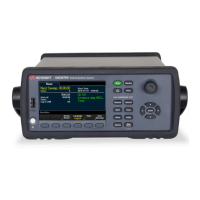<FROM USB>SYST:LOCK:REL
State = unlocked, Count = 0
– For each successful lock request, a lock release is required. Two requests require two releases.
– When a lock is active, bit 10 in the Standard Operation Register will be set (STATus:OPERation:CONDition? com-
mand). When the lock is released, this bit is cleared.
SYSTem:LOCK:REQuest?
Issues a request to lock the instrument's configuration to a single I/O interface. This allows you to lock the instru-
ment or share the instrument with other computers.
Parameter Typical return
(none) +1 (request granted) or +0 (request denied)
Requests a lock of the current I/O interface:SYST:LOCK:REQ?
– You can refer to the previous example to see the usage of this command with SYSTem:LOCK:RELease. For each
successful lock request, a lock release is required. Two requests require two releases.
– When a request is granted, only I/O sessions from the interface which was granted the lock will be allowed to
change the state of the instrument. From the other I/O interfaces, you can query the state of the instrument but
no instrument configuration changes or measurements are allowed.
– Lock requests can be nested and each request will increase the lock count by 1. For every request, you will need a
release from the same I/O interface (SYSTem:LOCK:RELease command).
– Instrument locks are handled at the I/O interface level (USB or Sockets) and you are responsible for all coordin-
ation between threads and/or programs on that interface.
– Locks from socket sessions will be automatically released when a socket disconnect is detected.
– When a lock is granted, bit 10 in the Standard Operation Register will be set (STATus:OPERation:CONDition?
command).
314
Keysight DAQ970A/DAQ973A Programming Guide
2 SCPI Programming

